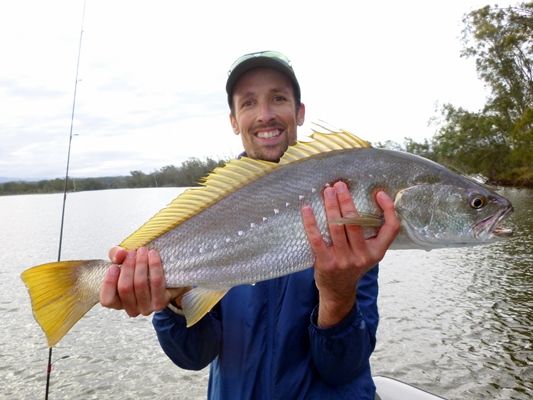Latest News
One more cast is all that’s needed for a fish of a lifetime
Monday, 12 May 2014
To the wives, husbands, girlfriends, boyfriends and children of anglers, I’m sorry. The following tale may inspire your beloved to stay out longer than they promised, leaving you waiting at home while they stand beside a river or lake somewhere muttering to themselves “one more cast, just one more cast”.
First some context and a brief fishing report from a recent weekend at Tuross Lake on the South Coast. The temperature might be dropping but the estuaries are still fishing pretty well. Whiting are launching the occasional raid on surface poppers, especially from the cover of slightly deeper water next to sand flats, and the bite-sized Storm Gomoku popper has been attracting more than its fair share of strikes. Bream are biting on curly-tailed soft plastics fished around fallen timber, especially in areas with tidal flow in 1 to 3 metres of water. The bigger bream, as is often the case, can be caught on shallow diving lures.
Flathead of all sizes are still active. Over the weekend we regularly caught flathead while targeting whiting and bream, but we were disappointed to lose two big fish. The first smacked a popper only to chew through the light leader line intended for a whiting. The second took a more conventional offering of a 70-100mm paddle-tailed soft plastic. Despite steady and constant pressure on the line, the hook came out and so it will remain the stuff of legends.
Wondering what had gone wrong, I retrieved the line and tested the hook by dragging it along my fingernail – a trick Rob Paxevanos taught me in his book. It immediately dug in: it was razor sharp. So why did the fish get off? On light outfits (4-6lb) popular for estuary lure fishing it can be difficult to apply enough pressure to insert the hook to the bend in the hard mouth of larger flathead. Striking hard risks breaking the line. As I mentioned a couple of weeks ago, it takes far less pressure to set a barbless hook than one with a barb, so the next step was obvious: I squashed down the barb with pliers and cast out again.
On the Saturday we had decided not to keep any fish, but with partners back home enquiring about fresh fish for dinner we agreed to keep a few on Sunday. I should know by now that this is a great way to jinx yourself. Sure enough, we struggled to catch anything on Sunday and after several hours had managed just five modest flathead between three anglers. One more fish, we all agreed, would be enough. Ten minutes before ‘home time’ I had a reasonable tug on the line. I started to reel it in and half way back to the boat it got off. It was definitely one of those days.
“One more cast” was announced.
There was another subtle tap on the line and as I lifted the rod, the startled fish swam off towards the cover of nearby trees. It was big and heavy and powerful; I struggled to slow it down. Was it another big flathead? After a couple of long minutes, a flash of silver and yellow appeared beneath the boat. A mulloway!
We slipped the net under the fish and whooped and hollered like school kids. I grabbed the soft plastic lure and the hook slipped straight out. It was the barbless hook from the day before – and it did its job perfectly. After a couple of quick photos and with no thoughts of keeping this fish, we returned it to the water and it disappeared back into the depths. Wow!
I’ve since wondered; if the much smaller fish had stayed on the line would we have called it a day? Would I have missed the mulloway? Possibly. But in all likelihood we would still have had one more cast. That’s the great thing about having ‘one more cast’; you’ve got to have a few of them to make sure the fish of a lifetime isn’t just around the corner.
Graham Fifield
Flickandflyjournal.com



